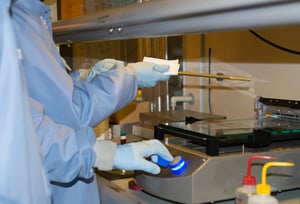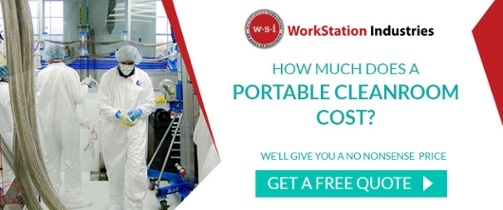A cleanroom is a specialized space controlled for particles in the environment that can impact your application, such as pollutants, contaminants, dust and microbes. It is used primarily for manufacturing, technology, military and scientific applications where contamination could be detrimental.
These spaces have features like a High Efficiency Particulate Air (HEPA) filter to trap unwanted particles and remove them from the space. They also have climate control and other cleanroom environment features to maintain the needed cleanliness requirements.
You can invest in a permanent clean room built into your floor plan, but a more portable and cost-effective solution is available. A modular cleanroom, also called a softwall clean room, provides this alternative. This type of space, which features cleanroom wall panels, is free-standing and lightweight, and you can assemble it almost anywhere.
Portable cleanrooms meet ISO clean room standards just like hardwall clean rooms and can hold fume hoods, workbenches and equipment, as needed. Since a portable clean room cost is much less than traditional cleanrooms, it can be a good option when you need a confirmable clean space.
There are five advantages of using modular clean room panels:
- Versatility
- Reconfiguration
- Cleanliness Control
- Cost.
- Lead Time
Versatility
A modular clean room can be assembled, disassembled or relocated at any time. This is especially important as businesses grow and change. While you may meet current cleanliness standards now, you anticipate that those standards will change in the future.
businesses grow and change. While you may meet current cleanliness standards now, you anticipate that those standards will change in the future.
You may also expect growth in the size of your operation, but constructing a new, permanent cleanroom each time you move into a larger workspace is cost prohibitive.
There is also versatility in the design of your clean room panels. Some feature windows, while others can feature cutouts or openings for lighting, filters, an HVAC system and other necessary tools for your workspace. Even the color of your wall panels can signify something important in your space, such as the various applications you may perform in your lab.
You can also customize clean room design to meet your industry's standards whether you need to adhere to ISO 9 or the strict ISO 1. When designing your space, like any room, you can add a variety of features to meet your needs, such as:
- Ducted and ductless fume hoods
- Cabinets
- Workbenches
- Countertops
- Storage tools
- Other pieces of furniture
It's always important to make sure these elements comply with cleanliness standards for the room or the workspace may not meet the appropriate specifications.
Reconfiguration
Modular systems are comparatively inexpensive to start, but you can also make them larger, smaller, change shapes or move entry points as needed ... saving you substantial costs in the long run.
shapes or move entry points as needed ... saving you substantial costs in the long run.
If you were to build a permanent clean room to lower ISO specifications and later need to meet more stringent specifications, you'll likely face significant costs to address these new requirements. Since standards can specify details like how close the door is to the workstation, changing the simple placement of a door can be extremely costly in a permanent structure.
However, because clean room modular wall systems are versatile and can be reconfigured, you can change the placement of the room panels and doorways to meet the new standards more easily and with fewer costs.
Cleanliness Control
Clean room procedures are critical to follow since they help to ensure the room is actually clean and that your application is less likely to be contaminated. Clean rooms are easy to retrofit as specifications and other requirements change to meet new cleanliness standards or to correct a previous misunderstanding of standards.
It's important to know your ISO classification before you install a clean room, though if your classification level changes, it's often easier to make adjustments in a modular clean room versus a permanent structure.
Within your modular clean room, several features are available to help you maintain your standard. You may have air samplers or settle plates to measure the level of contamination in the room. Your fume hood removes toxic vapors quickly, so technicians do not breathe them in. HEPA filters are there to trap particles as little as .3 micron in size. If you need to meet higher standards, Ultra Low Particulate Air (ULPA) is also an option.
Cost
Building a cleanroom the old-fashioned way can cost as much as $1,500 per square foot, so a small 10' x 10' clean room could cost $150,000. Why is a traditional clean room so expensive? There are several factors.
 You need multiple specialized contractors to work a clean room into the blueprints and build it to the clean room standards. Ductwork specialists will need to design and run separate ductwork for the room to manage airflow, and doors and windows may need to be moved, removed or replaced. Time is money in most cases, and it can take months to build a traditional clean room. Once it is built, it often can serve no other purpose than for what it was intended and may even cease to be a clean room.
You need multiple specialized contractors to work a clean room into the blueprints and build it to the clean room standards. Ductwork specialists will need to design and run separate ductwork for the room to manage airflow, and doors and windows may need to be moved, removed or replaced. Time is money in most cases, and it can take months to build a traditional clean room. Once it is built, it often can serve no other purpose than for what it was intended and may even cease to be a clean room.
A modular clean room provides you with a customized, clean environment at a fraction of the cost. The average portable clean room cost for a 10’ x 10’ portable clean room panel system is $10,000 to $15,000, depending on the controls and specifications needed.
The exact price you pay depends mostly on the level of standards you need to meet. ISO 1 rooms tend to cost more than ISO 4 and so on. However, you'd see this same rise in cost for a permanent clean room, the difference being that the costs would go up much more for each level.
Time is money in the case of a modular clean room that uses panels as well, but this time, in a positive way. Each modular cleanroom wall is pre-fabricated to meet cleanroom requirements, so a team can have the wall system up within a few days. And you can bring in your regular employees or contract labor to follow easy-to-follow manufacturer instructions.
You may also need industrial furniture, custom cabinets, workbenches, anti-static mats, electrical outlets and other clean room accessories. It's important to keep these in mind when determining how much you will pay when considering your options.
Lead Time
While building a regular cleanroom takes significant planning, considerable financial considerations and time, an experienced clean room manufacturer can deliver an ISO-compliant modular system in a fraction of the time that it takes to build a conventional cleanroom.
Because modular clean room construction can occur in as little as a few days to a few weeks for more complex rooms, softwall cleanrooms are perfect for companies who need to get a controlled space up quickly.
This has especially been the case of the past year when many companies have needed to switch gears to meet the high demand of supplies during COVID. Modular clean rooms provide the perfect sterile space in which to produce these often highly-regulated supplies.
Keep in mind that there are several factors that influence how quickly modular clean room panels can be installed and your lab can be up and running, including the furniture and materials used inside. For example, some lab countertop orders take longer to fulfill because certain materials aren't available as quickly as others. While a highly effective material to withstand the harsh conditions of a lab, epoxy resin is one of these materials since very few manufacturers make it.
Our article, How Long Does Modular Clean Room Construction Take? explains in more detail about how long you can expect construction of your modular clean room to take.
An Important Choice
Choosing between a modular clean room panel system and a more permanent structure often comes down to your application's needs, cost and construction timeline. The good news is, if your budget is tight or you anticipate application changes down the road, a modular clean room fit with versatile and customizable panels can be a great fit and get your lab up and running in a matter of weeks.


